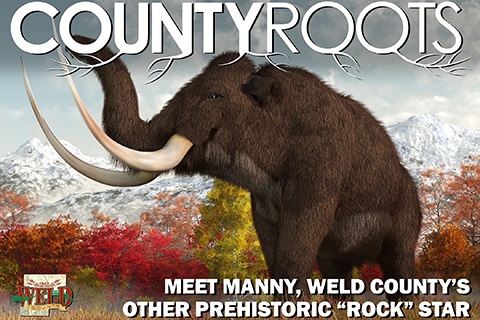Meet Manny, Weld County's Other "Rock" Star

We’ve been touting Pops the Triceratops quite a bit – after all, it’s an exciting project for all of Weld County as the story of the state’s most complete Triceratops skull continues to evolve through the scientific study being done at the Denver Museum of Nature & Science – but, did you know Weld County is home to another prehistoric “rock” star?
All that remains of the Dent railroad depot southeast of Milliken is a weathered sign.
But Lois Ann Onorato, Director of the Milliken Historical Society, remembers it as a discovery of prehistoric proportions.
In 1932, the South Platte River flooded; eroding away earth and uncovering mammoth bones going back to the Ice Age.
Railroad foreman, Frank Garner, reported the mammoth bones discovery to Michael Ryan, the depot master. As a result, Ryan’s son told his Regis College geology professor Father Conrad Bilgery. Bilgery then led an excavation of the site with his students.
After uncovering multiple mammoth bones, including a 45-inch thigh bone, a jaw bone that measures 17 inches from side to side, and a 26-inch-long shin bone, as well as two fluted spear points, Bilgery ceased the excavation and reported the find to Colorado Museum of Natural History (now the Denver Museum of Nature & Science) Director Jesse Dade Figgins.
With the help of Figgins, five adult female mammoth skeletons and ten young mammoths under two years old were discovered.
It was determined that these mammoth bones were from the Pleistocene era, and the spear points were from the Clovis Indian tribe who hunted the large wooly creatures. Evidence suggests that one or more herds were ambushed in a few kills by Clovis hunters who would have had knowledge of when the herds migrated.
Onorato, now 86 years old, was able to see the site firsthand after she moved to Milliken with her family in 1950 — when she was just 15.
“I knew Frank personally; he married my dad’s cousin,” Onorato explained. “Although I wasn’t alive in 1932, I grew up with Frank telling my family all about the discovery; how the town was abuzz with curiosity. Frank even took my family and I on tours of Dent a few times, which was neat to see the history up close!”
At the end of each day’s excavations, Garner visited Dent. In 1955, he gave the Denver Museum of Nature & Science a third Clovis Indian spear point, found near the teeth of a mammoth during the original 1932 discovery that he had kept for himself.
“Milliken residents recall the artifacts being displayed on the main street,” Onorato said. “Back in 2010, as a part of the town’s centennial celebration, we had a Manny the Mammoth Day where bones from the site were on display at the Milliken Police Department and there was a sandbox where kids could dig for fossils.”
Onorato also remembers buses picking up students at Dent and going to the houses by the depot in the late ’50s.
“When I was in high school, one of my cousin’s friends lived in a house at Dent. Her father worked for the railroad and their house was an old caboose,” Onorato said. “We would go see the site and see what progress was being made.”
The bones and spear points are speculated to be 11,000 years old, and according to a Milliken Historical Society document, there were no clear signs found to show the animals were killed at the site, the mammoths may have migrated to the site where they later died. Nonetheless, the discovery at Dent was the first connection between mammoth and man in the New World.
“I have visited Dent multiple times since I moved to Milliken when I was in high school,” Onorato said, smiling. “And even though I can’t go out there anymore, I’m glad I was able to experience firsthand the rich history of the site.”
By Shaley Dehner, Weld County Communications Specialist